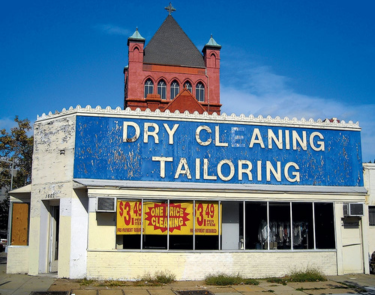Good Bones was built from several sources, including the ghosts of Studio’s neighborhood—the buildings and community that have changed over the past 45 years of Studio’s history. James Ijames had a few ideas in mind when he came to DC in June 2019 for a writer’s retreat to work on a newly commissioned play for Studio Theatre. One was a thriller about a couple new to a rapidly changing neighborhood, so Studio arranged a tour of the Shaw / U Street neighborhood with Shellée M. Haynesworth, historian and producer of the multimedia piece Black Broadway on U.

On the tour, Ijames noted a few things that would shape Good Bones: The proximity of newly restored row houses and the nearly anonymous concrete public housing. The number of ‘used to bes’: the restaurant that used to be a laundromat; the former homeless shelter that is now a set of condos called The Mission. His play would be, at its core, a ghost story: “Good Bones is really a play about haunting,” Ijames says. “You displace people. That history is still there. The energy of that community that used to be here is still there.”
Good Bones follows Aisha, a civil engineer who is renovating a house in the neighborhood she grew up in, having moved cross-country to land a few blocks from the public housing she was raised in. As she and her husband try to finish the renovation before their first child is born, their contractor Earl challenges them on the difference between buying a house and joining a community. He grew up in the same buildings that Aisha did but never left the neighborhood, and has a different perspective on the ways it’s changed.
Part of Ijames’s project was to keep his focus among Black people, looking at questions about what communities need and how to integrate into an existing system rather than dictate new terms for a neighborhood. Drawing on his own experiences as a new-to-the-neighborhood homeowner in South Philadelphia, Ijames is looking for models of interdependence instead of extraction or displacement. “I hope the play doesn’t just become just about gentrification in a pure sense,” Ijames says. “It’s about shifting how we think about neighborhoods and belonging.”
Because right now, he sees a lot of cities haunted by a history that’s been disappeared. “What does it mean when you just remove people?” Ijames asks. “It’s how we’ve answered problems in this country, historically: We remove things that we don’t want to think about—or we set up conditions in which we don’t have to think about the things we do.” Instead, his play offers a way to imagine ways for new community members to interlace themselves with the neighborhood’s history. Good Bones unspools its story of a complicated homecoming in the neighborhood that shaped it, among audiences who include some of the same ghosts that inspired the play.
— Adrien-Alice Hansel
